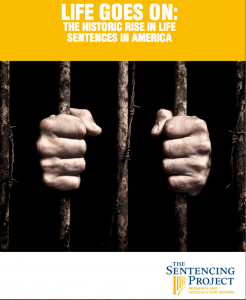 The Sentencing Project has released a new report, “Life Goes On: The Historic Rise In Life Sentences in America”, that describes the extraordinary increase in those sent to prison for Life [click on image on left for PDF copy] According to the report, “Last year, 159,520 people were serving life sentences in American prisons, a 12 percent increase from 2008. The number of individuals serving life without parole has increased even more dramatically, from 40,174 in 2008 to 49,081 in 2012 — a 22 percent rise.
The Sentencing Project has released a new report, “Life Goes On: The Historic Rise In Life Sentences in America”, that describes the extraordinary increase in those sent to prison for Life [click on image on left for PDF copy] According to the report, “Last year, 159,520 people were serving life sentences in American prisons, a 12 percent increase from 2008. The number of individuals serving life without parole has increased even more dramatically, from 40,174 in 2008 to 49,081 in 2012 — a 22 percent rise.
“Although most “lifers” have been convicted of homicide or sexual assault, the use of life sentences has expanded over time to include a wider range of offenses, including property crimes (5,416 prisoners) and drug crimes (2,686). In Idaho, prisoners who have not been convicted of homicide comprise more than half the population of lifers, the highest in the country; in Washington, they represent 46 percent.”
These statistics portray a troubling paradox in the current media narrative on prison reform. While prison reform has been embraced by nearly all, those who are sentenced to prison for more serious offenses are spending far longer than they did and in greater numbers than a few short years ago.
In an article I wrote in January 2012, “California prison terms for violent criminals more than double“, I quote from a Center on Juvenile and Criminal Justice (CJCJ) article, “California offenders who committed violent crimes can now expect to serve 7 years in prison — in 1990, they would have served less than 3. Looking at people who committed murder, those who were released in 2009 served an average of 16 years; now, they can expect to serve more than 50 years. This lengthening of sentences for violent crimes is a major reason California’s prisons are overflowing and will continue to do so. In 2009, nearly 100,000 of the state’s prison inmates were doing time for violent crimes, a number that will only grow as the exit door continues to recede.”
Lizzie Buchen’s who wrote that CJCJ article, argues that research coming out of the PEW Center of the States, supports the position that longer sentences are a major reason for the explosion in prison populations and the enormous cost of keeping prisoners locked up. (PDF of the PEW article, “Time Served; The High Cost, Low Return of Longer Prison Terms”)
Are we paying attention to the right prison reform statistics, or ignoring one of the most troubling of indicators, the appropriateness and rationality of the priosn terms that serious offenders are required to serve.

